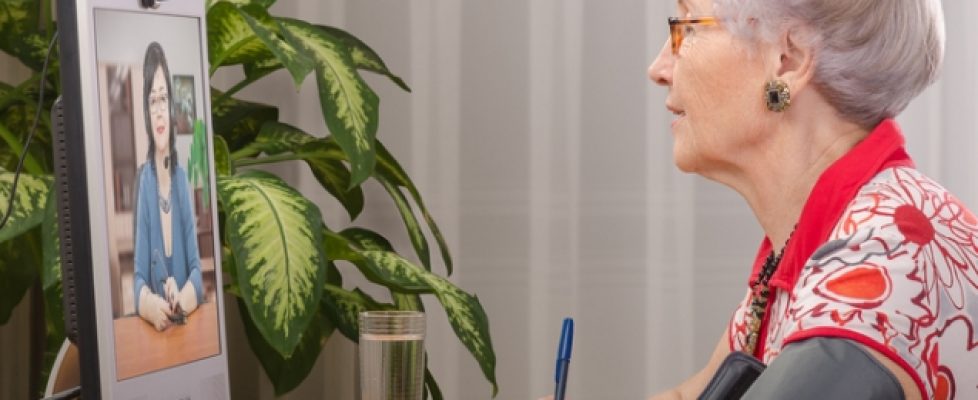What to know about the telehealth upsides of Medicare Advantage plans
Forthcoming policies from CMS will open up the home as a covered site of care in which hospitals can earn payment.

Susan Morse, Senior Editor
This past October, the Centers for Medicare and Medicaid Services came out with an eagerly-anticipated new rule expanding the ways providers can use telehealth and get paid by Medicare Advantage plans.
The biggest way the rule changes the status quo, once it goes into effect in 2020, is that providers will be able to keep track of a patient’s health through remote monitoring and consumers will be able to connect to their physicians through telehealth from their homes.
Let’s take a deeper look at what that will mean for healthcare executives considering implementing telehealth or remote patient monitoring tools.
IMPROVING CARE FOR CHRONIC CONDITIONS
Remote monitoring is especially important in controlling chronic conditions, diseases which affect seniors in particular.
Previously, consumers had to be in a provider’s office or another designated place, or live in a rural area, to use telehealth, at least from the standpoint of reimbursement.
Days after the MA rule dropped, traditional Medicare also got a boost to allow for more codes for telehealth in the home, for a broader range of conditions.
Remote patient monitoring is expected to be the biggest use.
This will cut down on the amount of visits by high utilizers of the ER and improve the management of patients’ conditions, said Dr. David McSwain, CMIO at Medical University of South Carolina..
“There’s a huge amount of investment from insurance companies,” said McSwain, who chairs the American Telemedicine Association Pediatric Telemedicine Guidelines Committee.
The rule makes it more likely that MA plans will offer the benefits and that more enrollees will be able to use the benefits, CMS said.
What’s more, private commercial insurers and state Medicaid agencies tend to follow Medicare’s lead, McSwain said.
CMS promoted Medicare Advantage plans ahead of open enrollment this year, and adding flexibility to telehealth only added to their attraction for insurers and consumers.
Insurers, as shown most recently by their third quarter earnings, are doing well with Medicare Advantage plans.
Next year, enrollment in Medicare Advantage is projected to increase by 11.5 percent, and the number of plans to increase by 600.
About a third of all Medicare beneficiaries are in a Medicare Advantage plan as compared to fee-for-service Medicare, and that number is projected to grow.
Adding telehealth to MA benefits increases plans’ ability to take cost out of the healthcare system. If telehealth can do so without sacrificing quality, that’s the basis of value-based care.
HOW PROVIDERS ARE ALREADY USING TELEHEALTH
The challenge to the convenience is the potential for over-utilization, according to McSwain. There’s the risk of fragmented care.
But telehealth can have dramatic impacts on healthcare outcomes and healthcare costs, he said.
Telehealth is driving value, CMS Administrator Seema Verma said on November 15, addressing the Alliance for Connected Care.
Telehealth includes remote monitoring, such as for glucose and vital signs, tracking weight and blood pressure. It spans a wide array of communication, from video visits to text messaging and phone calls.
Medicare-age patients often have numerous doctors’ appointments. Consumers welcome the ability to connect from their homes rather than travelling to the office. Patients with restricted mobility will often miss appointments.
The Cleveland Clinic uses remote patient monitoring that sends live-time data back to clinicians, Verma said during the Alliance for Connected Care conference. A mission control center at the hospital assimilates the data and if needed, triggers an intervention.
About five years ago, Dallas Children’s Health wanted to look at telemedicine as a strategy for population health, said Julie Hall-Barrow, former vice president of Virtual Health and now the senior vice president of Network Development and Innovation.
Telehealth is being used in the children’s hospital for remote patient monitoring programs, such as digital sensors that measure medication compliance.
“We set the stage knowing it’s covered,” Hall-Barrow said of reimbursement. “I think anytime we reduce barriers for how to deliver care, it’s a win for everybody,” she said. It offers,”the ability for us to provide high quality care at any delivery point.”
The big picture for telehealth is how to design programs in a way that lead to improved outcomes that have the biggest impact on cost of care access and quality, McSwain said.
The Medical University of South Carolina is one of only two national Telehealth Centers of Excellence in the United States. The system is currently awaiting word on a National Institutes of Health grant that would allow it to leverage a network of healthcare institutions across the country to facility the design and completion of telehealth studies, such as what is being taught at MUSC.
Bryan Adams, chief commercial officer at digital health company GreatCall, said of telehealth, “Everyone is interested. Everyone is trying to find out the right entry point.”
GreatCall provides cell phones, medical alert devices and sensors for independent living at home. Sensors can monitor for risk, such as for falls from a bed or chair, or even be put in the tank of a toilet to detect toilet flushes.
The use of the sensor has resulted in the reduction in the use of long-term care and acute hospitalization, Adams said.
“This is truly a whole new world of healthcare innovation,” Verma said of telehealth.
McSwain added that CMS’s new flexibilities “sent a serious wave of excitement around the country. We’ve been fighting the battle for telehealth in the home, it’s been such a barrier. Those restrictions coming down. It’s like the Berlin Wall.”

